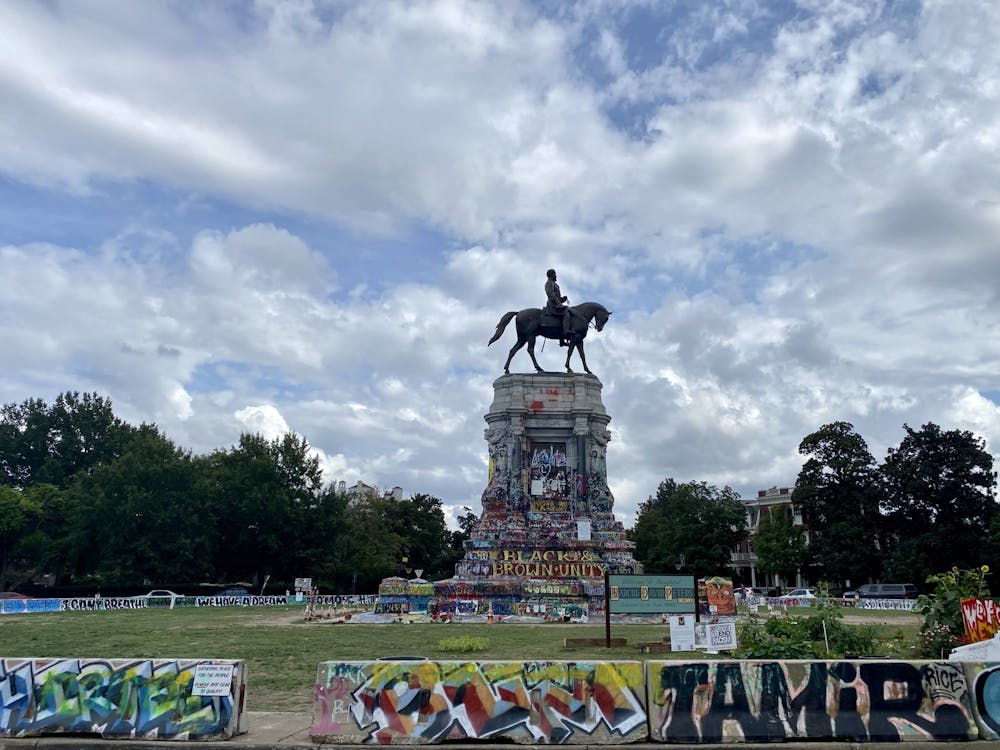Editor's Note: This article contains expletive language.
As protests over police brutality and racism erupted across the United States and the world this past summer, many people began examining who is memorialized and why. The monuments to Confederate figures on Richmond’s Monument Avenue became a focal point.
On June 3, Richmond Mayor Levar Stoney announced his intent to introduce an ordinance to remove all city-owned Confederate monuments from Monument Avenue. Stoney officially ordered the removal on July 1, citing public safety reasons. On June 4, Virginia Gov. Ralph Northam ordered the removal of the state-owned monument to Confederate Gen. Robert E. Lee. Throughout the summer, protesters graffitied and toppled several Confederate statues in Richmond.
At the time of this article's publication, all but one of the Confederate monuments on Monument Avenue have been removed. On Aug. 3, a judge issued the latest of multiple injunctions temporarily blocking the removal of the remaining Confederate monument — the Lee monument. Now covered in graffiti, the Lee monument has become an epicenter for protests as well as a gathering site for Black dancers, musicians and artists.
Senior Lucy Cummins, who participated in the protests in Richmond over the summer, said on June 5 that many of the protest locations and the narratives of people who spoke at the protests had centered around Monument Avenue.
“I think especially now it’s really important that symbols of the Confederacy are removed across the country because they have no place in a society that strives for equality,” Cummins said.
When Northam and Stoney announced their plans to remove Confederate statues, Cummins said she was excited but hoped that change would not stop there.
“I think I can see why government officials would’ve decided that this is an opportune time to do this,” Cummins said. “I think it’s great that it’s happening, but I also hope that this isn’t the only response to everything that’s currently going on, with the protests and the issues with police brutality in Richmond and across the country, because it is a symbolic move. So I hope that it comes along with some real action.”
On June 6, days after Northam ordered the removal of the Lee monument, senior Gabe Josephs agreed that it was easy to dismiss the removal of the monument as a purely symbolic gesture. However, he emphasized that symbols have meaning.
“Symbols are powerful,” Josephs said. “Just the erection of the [Lee] statue was, you know, as I said, a ‘fuck you’ to Black southerners, the removal of it is a symbol itself of that stage of people power, of that stage of a movement and a people who decided, ‘These are not the values — this statue does not reflect the values of the South.’”
Josephs, who was raised in the Bahamas, said he had been first introduced to the debate over the Monument Avenue monuments when he arrived in Richmond for college in 2017, shortly after the Unite the Right rally occurred in Charlottesville, VA.
“I just generally knew [that] the South lost in the Civil War, and I was somewhat shocked that these sort of illustrious statues memorialized losers, essentially,” Josephs said. “When I moved in, like a week or two before I moved in my freshman year, was Charlottesville and the rally and all of that. So that was sort of my first introduction to the Confederate monument debate.”
Enjoy what you're reading?
Signup for our newsletter
He cited the time period when the Confederate monuments on Monument Avenue were erected, from 1890 to 1929, as a reason why he thinks they should be removed.
“[The erection of the monuments] wasn’t to memorialize the Civil War,” Josephs said. “It was about two or three degrees of separation, two or three generations removed from the Civil War … I think there should be something to replace them. Conceptually monuments on Monument Avenue makes a great deal of sense, but it should be reflective of the values of this generation and this new South.”
Josephs thinks moving the Confederate monuments — in their current form, with the graffiti intact — to a museum would be an effective way to contextualize them, he said. He compared this idea to how the Berlin Wall was preserved.
“The [Berlin] Wall came down, and all of the graffiti — it was cut into pieces and sent all over the world — but all of the graffiti was preserved,” Josephs said. “It was never cleaned … There’s one piece of the Berlin Wall at the CIA museum, or in front of the CIA museum, and it’s this incredible, huge piece of concrete, and what sort of enlivens it is the graffiti on it.”
On Sep. 7, Josephs said that he maintained his support for the removal of all Confederate statues on Monument Avenue.
“I continue to be disturbed that a 150-year-old slave owner who fought to preserve the institution [of slavery] in the United States has such fervent defenders in this country,” Josephs said. “But, you know, it is what it is, and at the end of the day I think the arc — I don’t want to sound too teleological — but the arc of history bends toward justice, so they say.”
Ernest McGowen, professor of political science and the Race and Racism Project’s coordinator, said he saw the recent protests and graffiting of monuments as people expressing their political preferences between elections.
“Elections are the main time when we express our preferences for how we want government to work,” McGowen said. “The way the system happens is that people — we put people in office, they do what we like or they do what we don’t like, and if we don’t like what they do, then we have to wait until the next election to put somebody else in office.
“People going outside and actually using their ropes and trucks and all that other kind of stuff, them buying spray paint to deface the monuments, if you will, is their expression of their political preference.”
Virginia citizens and judges have made efforts to block the removal of Confederate monuments, including Bradley Cavedo, a UR alumnus and Richmond Circuit Court judge, who granted injunctions to block the removal of the Lee monument as well as other Confederate statues in Richmond.
An opinion piece Cavedo wrote for The Collegian in 1977 critiquing desegregation busing, instant voter registration and other aspects of the U.S. government at the time resurfaced this summer following his rulings on the monuments.
McGowen said he was proud to see a UR alumnus influencing what has been happening in society.
“I’m glad that a Spider who was able to express their ideals in college and then also climb to some of the highest levels of civil service in our society is staying true to their self and is actually going out and being able to put their public preferences out,” McGowen said.
Disagreement is vital when it comes to debate about Monument Avenue, he said.
“I’m a teacher,” he said. “I want disagreement. I want you to disagree with what’s going on in the classroom. I want people to challenge you and then make you refine your views in such a way where you are able to succeed, and it appears that that’s what’s happening.”
McGowen sees the debate about the Confederate monuments as one over the use of public versus private space, he said, pointing out that tax dollars are used to maintain monuments.
“What [many people who want the monuments removed] are saying is they don’t want these monuments in public spaces that they pay for,” he said. “Now, the second someone comes out and says, ‘Oh, well, I want Robert E. Lee to sit on my front lawn,’ [people] may protest that, but if they actually go to that person’s front lawn and pull down the statue or deface the statue, then they are actually encroaching on that person’s private space. But we’re talking about monuments in public spaces.”
McGowen believes the erection of the statues was the result of who had a political voice at the time, he said.
“There were a lot of people who didn’t want the monuments up when they actually went up, right — but [they] didn’t have a political voice,” McGowen said. “As with now, I think we’re in a situation where now the people who have been given a political voice don’t want the monuments up, and so they are taking them down.”
Northam has vowed to take down the Lee monument if a judge lifts the injunction barring its removal. For now, it remains unclear when or whether the Lee monument will be removed, what will be done with the monuments that have been removed and what the new Monument Avenue will look like.
Editor-in-chief Olivia Diaz contributed to reporting.
Contact managing editor Emma Davis at emma.davis@richmond.edu.
Support independent student media
You can make a tax-deductible donation by clicking the button below, which takes you to our secure PayPal account. The page is set up to receive contributions in whatever amount you designate. We look forward to using the money we raise to further our mission of providing honest and accurate information to students, faculty, staff, alumni and others in the general public.
Donate Now



